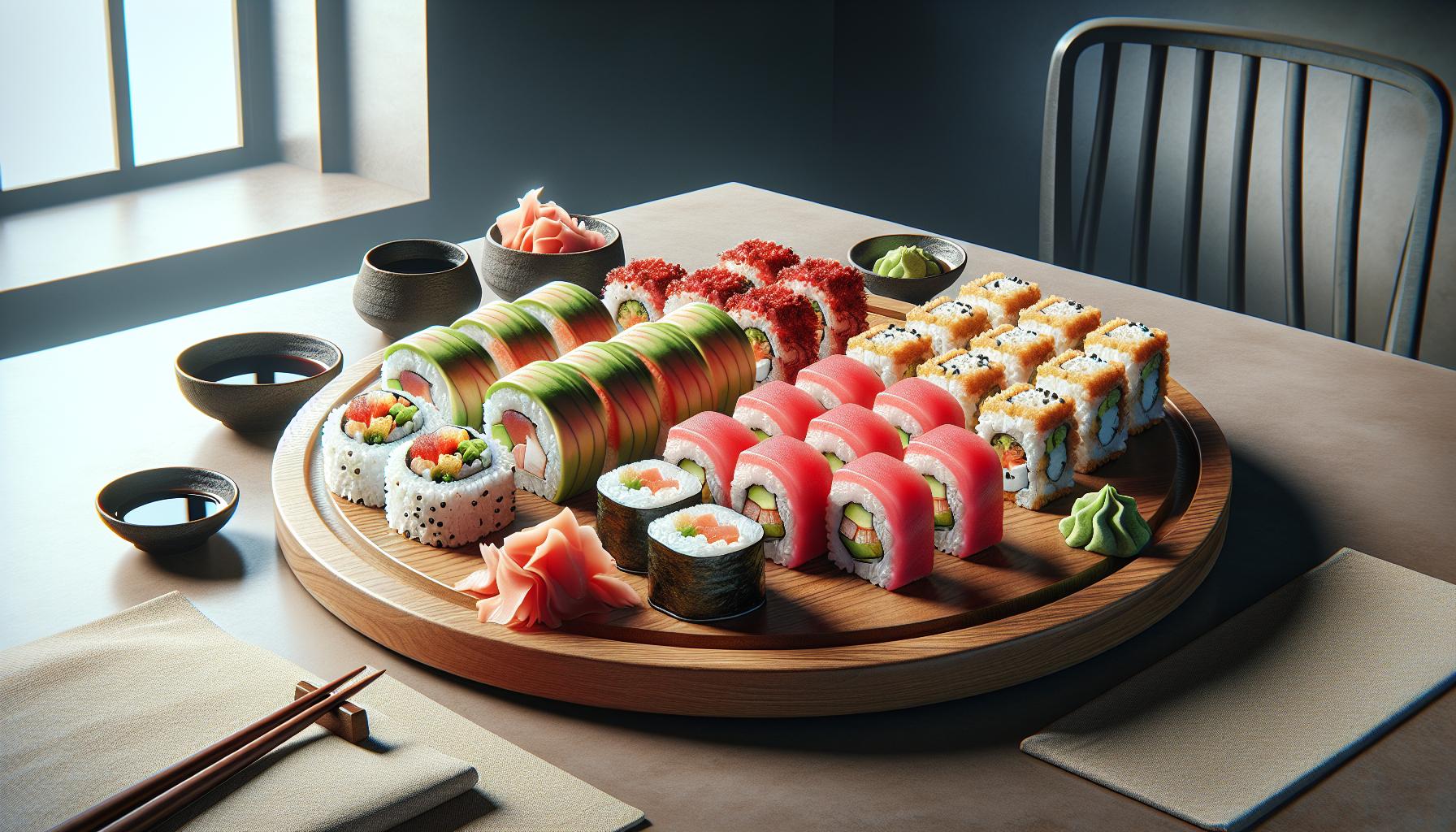Sushi rolls are a delightful blend of flavors and textures that have captured the hearts of food lovers around the world. But as I indulge in these tasty bites, I often wonder about their nutritional value. Are they as healthy as they seem, or are there hidden calories lurking beneath that delicious exterior?
In this article, I’ll dive into the nutrition facts of sushi rolls, breaking down the ingredients that make up your favorite rolls. From the health benefits of fish to the carbs in rice, understanding what’s on your plate can help you make more informed choices. Whether you’re a sushi aficionado or just starting to explore this culinary gem, knowing the nutrition behind your meal can enhance your dining experience.
- Nutritional Variety: Sushi rolls comprise vinegared rice, fish, and various vegetables, offering diverse nutritional benefits, including proteins and healthy fats.
- Caloric Differences: Sushi rolls vary widely in calories; for example, California rolls average 250 calories while tempura rolls can reach 400 calories or more due to fried ingredients.
- Protein Source: Fish in sushi rolls, such as salmon and tuna, provides high-quality protein essential for muscle growth and overall health.
- Heart Health Benefits: Sushi, especially with fatty fish, is rich in omega-3 fatty acids, which support heart health and help reduce inflammation.
- Watch Sauces and Fillings: Additional ingredients like sauces or tempura can significantly increase caloric intake, so being mindful of these components is crucial.
- Dietary Considerations: Pay attention to potential allergens and dietary restrictions, choosing vegetarian or gluten-free options when necessary for a safer dining experience.
Sushi Roll Nutrition Facts
Sushi rolls consist of vinegared rice combined with various fillings, wrapped in seaweed or served in bowls. Popular types of sushi rolls, like California rolls, spider rolls, and spicy tuna rolls, vary widely in nutrition based on their ingredients.
Fish provides essential omega-3 fatty acids. Salmon and tuna, common ingredients, offer protein and support heart health. Vegetables like cucumber and avocado add fiber and vitamins, enhancing nutritional profiles.
Rice acts as the primary carbohydrate source. Sushi rice, seasoned with vinegar, contains about 36 grams of carbohydrates per cup. Understanding the balance of carbs and protein in sushi rolls aids in evaluating overall health benefits while enjoying these flavorful dishes.
Sauces and additional toppings significantly influence calorie counts. For instance, eel sauce or cream cheese can add several calories. It’s important to consider these elements when assessing sushi roll nutrition values.
Here’s a basic nutritional comparison of several standard sushi rolls:
| Sushi Roll Type | Calories | Protein (g) | Carbohydrates (g) | Fat (g) |
|---|---|---|---|---|
| California Roll | 255 | 9 | 34 | 7 |
| Spicy Tuna Roll | 290 | 13 | 36 | 9 |
| Rainbow Roll | 400 | 21 | 50 | 12 |
| Tempura Roll | 500 | 14 | 63 | 20 |
Knowing these facts allows me to make informed choices about sushi rolls, balancing enjoyment with health considerations.
Key Ingredients in Sushi Rolls

Sushi rolls contain diverse ingredients that provide various nutritional benefits. Understanding these key components helps assess their health value.
Rice Nutrition
Rice serves as the primary carbohydrate in sushi, providing about 36 grams of carbohydrates per cup. Sushi rice typically contains a moderate glycemic index, making it a quick energy source. It’s often seasoned with rice vinegar, which adds flavor and benefits digestion. Moreover, it contains small amounts of protein and essential vitamins B1 and B3, contributing to energy metabolism.
Fish and Seafood Nutrition
Fish and seafood play a crucial role in sushi rolls, delivering essential nutrients like omega-3 fatty acids, high-quality protein, and vital vitamins. Salmon and tuna, commonly used in rolls, are rich in omega-3s, supporting heart health and reducing inflammation. For instance, a 3-ounce serving of salmon provides about 22 grams of protein and approximately 1,500 milligrams of omega-3s. Shellfish, such as shrimp and crab, contribute additional protein with low calories, enhancing the overall nutritional profile of the rolls.
Vegetables and Additional Fillings
Vegetables and other fillings enhance sushi’s nutritional impact. Common options like cucumber and avocado offer dietary fiber, vitamins, and healthy fats. Cucumber, being low in calories, adds hydration, while a half an avocado contains around 15 grams of healthy monounsaturated fats and nearly 5 grams of fiber. Additional fillings such as carrots and bell peppers further increase vitamin A and C intake. When combined with fish and rice, these ingredients balance the rolls, promoting a healthier meal option.
Nutritional Breakdown of Popular Sushi Rolls

Sushi rolls vary in nutrition based on their ingredients. Here’s a look at the nutritional profiles of some popular options.
California Roll
California rolls typically contain imitation crab, avocado, and cucumber, wrapped in rice and seaweed. One standard California roll (about 8 pieces) offers approximately 250 calories, 10 grams of protein, 36 grams of carbohydrates, and 7 grams of fat. The inclusion of avocado adds healthy monounsaturated fats and fiber, contributing to heart health and digestive wellness. Imitation crab provides protein but often contains added sodium, so checking the label is vital.
Spicy Tuna Roll
Spicy tuna rolls consist of raw tuna mixed with spicy mayonnaise, along with cucumber and rice. A standard spicy tuna roll (8 pieces) contains around 290 calories, 16 grams of protein, 32 grams of carbohydrates, and 13 grams of fat. Tuna offers high-quality protein and significant omega-3 fatty acids, supporting overall heart health. The spicy mayonnaise increases the calorie count, so adjusting portion sizes may be necessary for those monitoring caloric intake.
Tempura Roll
Tempura rolls include deep-fried ingredients, such as shrimp or vegetables, wrapped in rice and seaweed. One tempura roll (about 8 pieces) can contain around 350-400 calories, 12 grams of protein, 38 grams of carbohydrates, and 20 grams of fat. The frying process increases the fat content, often making tempura rolls heavier than other types. While they provide a satisfying crunch, consuming them in moderation allows for enjoying the flavors without excessive calorie intake.
Health Benefits of Sushi Rolls

Sushi rolls offer numerous health benefits, primarily due to their rich nutritional profile. The blend of fish, vegetables, and rice contributes to their appeal from a health perspective.
High Protein Content
Sushi rolls deliver significant protein, essential for muscle repair and growth. A typical serving of fish like salmon or tuna provides about 22 grams of protein per 3-ounce portion. Rolls containing shrimp or crab also contribute to overall protein intake, with shrimp providing roughly 20 grams per 3 ounces. Protein from these sources aids in maintaining energy levels, building enzymes, and supporting the immune system. The combination of fish and plant-based ingredients ensures sushi rolls are an excellent protein-rich meal option.
Omega-3 Fatty Acids
Sushi rolls, particularly those with fatty fish, are excellent sources of omega-3 fatty acids. A 3-ounce serving of salmon can contain up to 1,500 milligrams of omega-3s, which play a vital role in heart health and cognitive function. Omega-3 fatty acids help reduce inflammation, lower blood pressure, and improve overall cardiovascular health. Incorporating sushi into a balanced diet supplies these beneficial fats, contributing to long-term health outcomes.
Considerations for Sushi Roll Consumption
sushi roll nutrition facts offer diverse flavors and nutritional benefits, but some factors affect overall health choices. I’ll explore the caloric intake and potential allergens or dietary restrictions associated with sushi consumption.
Caloric Intake
Caloric content varies significantly among different sushi rolls. Popular rolls like the California roll average around 250 calories per serving, while others, such as the tempura roll, can range from 350 to 400 calories due to deep-fried fillings. I find it essential to pay attention to portion sizes and specific ingredients. When enjoying multiple rolls, the total caloric intake can add up quickly, especially with high-calorie options like creamy sauces or fried ingredients. Monitoring caloric intake helps maintain a balanced diet while indulging in sushi.
Allergies and Dietary Restrictions
Allergies and dietary restrictions play a crucial role in sushi consumption. Common allergens in sushi include shellfish, fish, and soy, often found in sauces or marinades. I recommend always checking ingredient lists for sushi options. For vegetarians or those avoiding seafood, choices like vegetable rolls or avocado rolls provide tasty alternatives. Furthermore, gluten-free options exist, though I advise ensuring the rice and nori are certified gluten-free, as cross-contamination can occur. Understanding personal dietary needs and allergies paves the way for enjoyable sushi experiences.
Delightful Mix
sushi roll nutrition facts offer a delightful mix of flavors and textures while packing a nutritional punch. By choosing wisely and being mindful of ingredients I can enjoy the benefits of omega-3 fatty acids and high-quality protein. It’s essential to balance enjoyment with health considerations.
I’ve learned that not all sushi rolls are created equal. Some can be calorie-dense while others provide a wealth of nutrients. By being aware of what goes into my sushi I can make informed choices that align with my dietary goals.
Whether I’m indulging in a classic California roll or a spicy tuna roll it’s clear that sushi can be part of a healthy diet. With a little knowledge I can savor every bite while nourishing my body.

